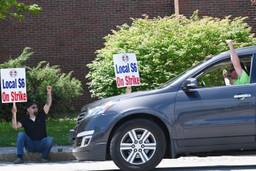Day One of RNC 2008 was a study in contrasts: Between vocal, colorful protesters and silent swat cops clad in black. Between peaceful and provocative protests. And between the streets, where something newsworthy was happening, and the convention, where nothing was happening.
Outdoors, throughout a portion of downtown St. Paul, a 10,000 strong throng marched at 1 p.m. from the capitol to the Excel Center and back again (anyone who claims 50,000 attended must have been drunk or sunburnt). The weather and setting were perfect -- if you could ignore phalanxes of battle-ready faceless commandos, apparently ready for a major insurrection.
I've never seen anything like it (see photos in previous post). But then again, this is my first political convention.
The main protest, which I followed closely until it reached the Excel Center, was a peaceful parade, two-thirds anger and one-third theater, featuring many well-known anti-war groups. I was impressed with how many middle-aged people were there, and how diligent protest organizers were keeping attendees in line to avoid altercations with police and counter-protestors.
But I couldn't help feeling like the whole event was trapped in an echo chamber. There were no drivers idling at cross streets, no curious pedestrians wondering what to make of the spectacle. The police made sure the proceedings occurred in a parallel urban universe, as delegates made their way to the Excel Center in the early afternoon just blocks away.
Did even one Republican switch parties today in St. Paul? This is a purely rhetorical question.
Any visiting Republican (and there don't seem to be many resident Republicans here) certainly wasn't dissuaded from the GOP's righteousness by watching clashes along Kellogg Boulevard, which I witnessed between 3:45 and 4:15 p.m. (They began much earlier, albeit elsewhere. A friend spent the entire afternoon, beginning well before the main march began, with this separate group, likely the RNC Welcoming Committee. The WC was apparently not defanged by pre-convention raids Friday night and Saturday. [NOTE: see update below])
Perched above the Mississippi, the boulevard played host to tear gas clouds and a handful of arrests. The provocateurs weren't all innocent: I witnessed bottles thrown. (I hope the shots I heard were only rubber bullets fired over the river.)
The goal, apparently, was to block delegates from traveling to the convention. I doubt the clash produced this result, but it did temporarily stop guests staying in hotels along the boulevard from going anywhere. (It also made a bogus convention day genuinely interesting.)
Indoors, of course, was the convention itself, which I entered at 4:30, nearly 90 minutes after it was convened. Just three blocks from the Kellogg clashes, it was an absurdly over-produced party: all gussied up with nothing to do but approve a boilerplate platform. (Laura Bush introduced four video postcards from Republican Gulf State governors. If you don't think the GOP is trying to boost its fortunes through Gustav, you haven't heard Texas governor Rick Perry say: "You're seeing Republican governors in, I think, Republican states, taking care of citizens. That's what we do.")
Then the First Librarian introduced Cindy McCain, who quickly repeated her husband's new favorite line: "This is a time to take off our Republican hats, and put on our American hats."
More non-news. But then what did I expect - I was at a political convention. The most interesting thing, for me, a lapsed Catholic, was the chance to look down on the delegates as they bowed their heads in prayer. A St. Paul priest invoked a higher power. "Bless our president," he said.
[UPDATE: I wrongly assumed the group of protesters clashing with police along Kellogg Boulevard was connected to the RNC Welcoming Committee. In fact, the demonstrators toting boom-boxes on wheels were members of DC Students for a Democratic Society, and their RNC campaign was called Funk the War. But the boulevard protesters were an amorphous lot; members of the black bloc and the welcoming committee could have been part of the demonstration, while I was there or earlier. Or not. It's hard to say what was happening to who when tear gas and cops on horses are around.]
Jeremy Gantz is an In These Times contributing editor working at Time magazine.





